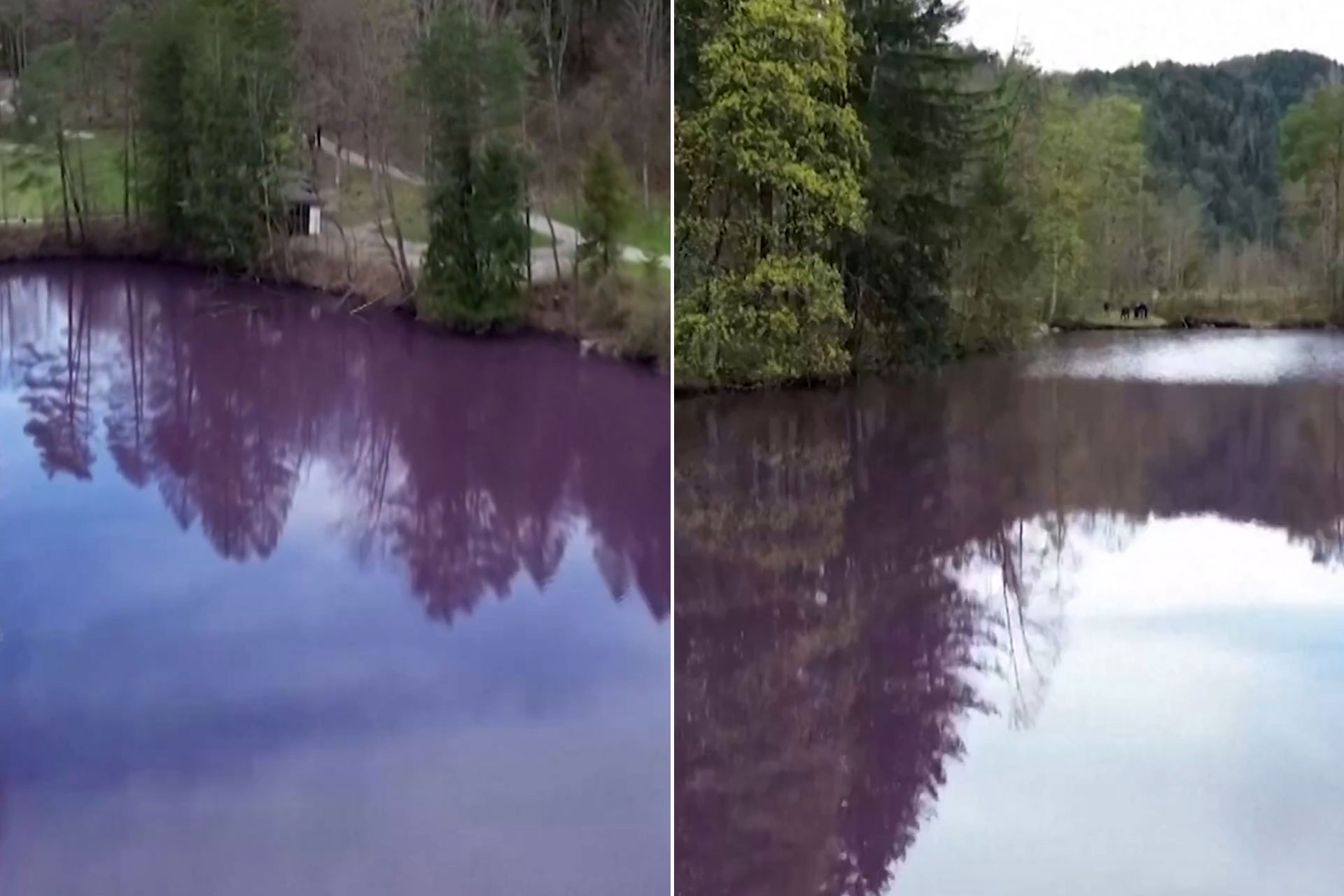Purple sulfur bacteria cause a German lake to change color (social networking sites)
Since yesterday, Wednesday, visitors have begun to flock to Lake Allgäu in the Bavarian Alpine state in Germany, after its water turned dark purple.
The state environment office said that purple sulfur bacteria, which are usually found deep in the lake, are behind the change in water color, as they recently made their way to the surface of the water.
The purple lake, also called the “Gypsum Quarry Pond,” is located in the Faulenbacher Tal Valley, in the city of Füssen, which has a population of about 20,000 people and is located one kilometer from the Austrian border.
CHECK THIS OUT- Visitors flocked to see a lake that turned a deep purple color in the Bavarian alps in Germany on Wednesday. The state environment office said the unusual color is from Sulfur bacteria that is normally found in deep water that made its way to the water's surface. pic.twitter.com/asfVXTDg88
— KION News Channel 46 (@KIONnews) April 4, 2024
According to experts, the purple bacteria necessary for this transformation are found in small bodies of water, and this can also happen in very deep lakes, where there is almost no oxygen in the deeper layers.
A spokesman for the city of Fussen says about this phenomenon, “Changing the color of Lake Allgäu to purple requires the presence of so-called purple bacteria, in addition to certain other conditions, as both the concentration of sulfur in the water and the intensity of light play an important role in changing the color of the lake.”
He added, "This is not the first time we have seen this phenomenon, but it does not occur at regular intervals, as the last time the lake glowed purple was in 2020 and 2021."
The Allgäu pond is located in the Faulenbacher Tal Valley, which owes its name to the sulfur springs and the smell of sulfur that prevailed there, which was carried with it by the flowing Faulenbach River, explains Stefan Friedelmeyer, Füssen's tourism director.
Since many of the ponds and lakes in the Faulenbacher Valley are still connected underground, the purple color of the water can be seen again and again in the valley's various bodies of water, says Friedelmeyer, who advises anyone who wants to see the phenomenon with their own eyes to hurry, saying, "The color "It is now weaker and could disappear completely with the next rains."
Does the phenomenon represent a health risk?
Regarding the health consequences of this color change, the city spokesman denied any harm to the colored water, saying, “There is no need to worry about pedestrians who come into contact with the lake’s discolored water, as the purple bacteria are not dangerous.”
According to Karl Schendel, head of the city's responsible water management office, the purple bacteria now blooming are "harmless and do not pose any risk to human or animal health."
He added that in contrast to the blue-green algae that also arises from time to time in lakes, the purple bacteria do not produce any toxins.
He continued, "At the present time, it is unlikely that anyone will go swimming in Algoi Pond because it is not the swimming season currently and the water smells of sulfur."
Bacteria turned Altsee into a "bleeding lake"
The Alatsi region near Füssen is also famous for this phenomenon, as it is only 3 kilometers from Lake Allgäu.
Lake Alatsi has the highest percentage of hydrogen sulphide among all lakes in Central Europe, and contains a layer of red and purple sulfur bacteria at a depth of about 5 meters that is impenetrable even to divers.
For this reason, Lake Alatsi is also called the “Bleeding Lake”, as the legendary lake has already become the basis of many books and stories.
What is purple sulfur bacteria?
Purple sulfur bacteria are photoautotrophs that perform anoxygenic photosynthesis, and consist of single-celled organisms.
Scientifically, the term purple sulfur bacteria was used for the first time by the German scientist Gundula Paffendam in 1924, to refer to all those purple bacteria that follow the path of non-oxidative photosynthesis, that is, without using water as an electron donor (and thus without producing oxygen). Rather, purple bacteria By oxidizing sulfide and storing the resulting sulfur either inside or outside the cells.
Why do some mountain lakes appear turquoise?
Scientists say the reason some mountain lakes appear turquoise is because the melting glacier water is moving slowly and steadily downward, removing tiny rock particles from the rocks below like giant sandpaper.
Travelogue Day 8, Lake Louise, Alberta to Kalispell, Montana, with a side-trip to Glacier National Park. pic.twitter.com/2bKhRtHctL
— Doug Robbins (@dougrbbns) July 9, 2023
As this rock powder mixes with water in mountain lakes, due to its low weight, the rock particles float in the water for a long time or sink slowly.
When sunlight hits the lake, the stone particles absorb a large portion of the light spectrum and reflect primarily the short-wavelength blue-green portion of the light, so lakes appear turquoise like Lake Louise in the Canadian Rockies.
Lake Louise, Yoho National Park pic.twitter.com/AK9W3JaDea
— Globally United (@unitingcultures) December 15, 2022
If a lake is a fairly calm body of water with little inflow and outflow of meltwater, over time the particles will sink to the bottom of the lake and appear clear turquoise.
On the other hand, if a lake has a constant outward and inward flow, masses of water are constantly moving and rock particles remain in suspension, making the lake appear “dull” and opaque, which is why meltwater is often referred to as “ice milk.”
Source: Al Jazeera + websites + social networking sites

